The beauty devices market in China is one of the most promising ones in the beauty industry, and an incredible growth of 325% has been observed on Tmall. Tmall is a popular online marketplace in China, and this surge in China’s beauty device market showcases the increasing demand for these products among Chinese consumers.
Beauty devices refer to electronic tools or devices that are used for various beauty and skincare purposes, such as facial cleansing, hair removal, or anti-aging treatments. The significant growth in this market on Tmall indicates a growing interest in at-home beauty treatments and the desire for convenient and effective skincare solutions.
It’s an exciting time for the beauty devices industry in China, and it will be interesting to see how this market continues to evolve in the future.
Beauty devices market overview
According to Vynz research, the Asia-Pacific beauty devices market is expected to reach USD 36.9 billion by 2024 and China is the largest beauty device market in the region due to the aging population, the high prevalence of skin diseases, and the high disposable income.
As technology becomes increasingly intertwined with the beauty industry and consumers become more comfortable with smart devices, chances are growth in the beauty device market will only continue to climb.
However, although, the use of devices for enhancing beauty and improving physical experience has been on the rise lately, it is also noticed that the NMPA (The National Medical Products Administration) imposed strict acceptance criteria for such devices.
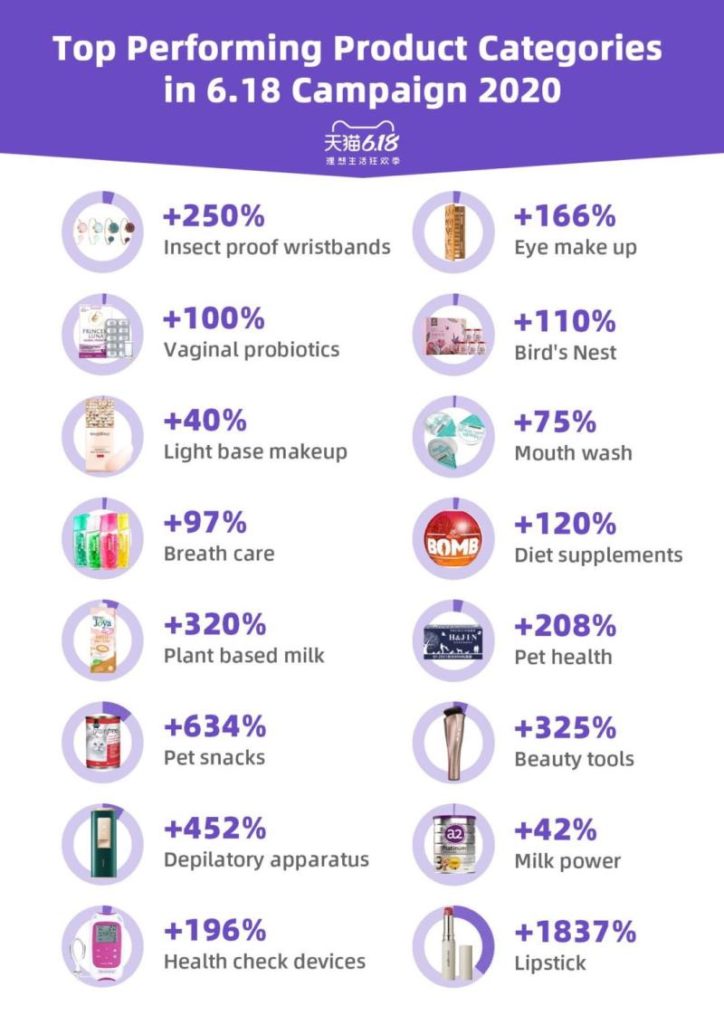
What is the Segmentation of Beauty Devices?
On the basis of product type and their related devices, the market is segmented into:
- Hair care (hair removal devices, hair growth devices, hair styling devices)
- Skincare (light/LED and photorejuvenation therapy devices, cellulite reduction devices, acne removal devices, skin dermal rollers, oxygen and steamer devices)
- Oral Healthcare Devices
In China, hair removal devices hold the largest market share due to the growing awareness of hair loss and the availability of a wide range of hair removal devices such as epilators and razors.
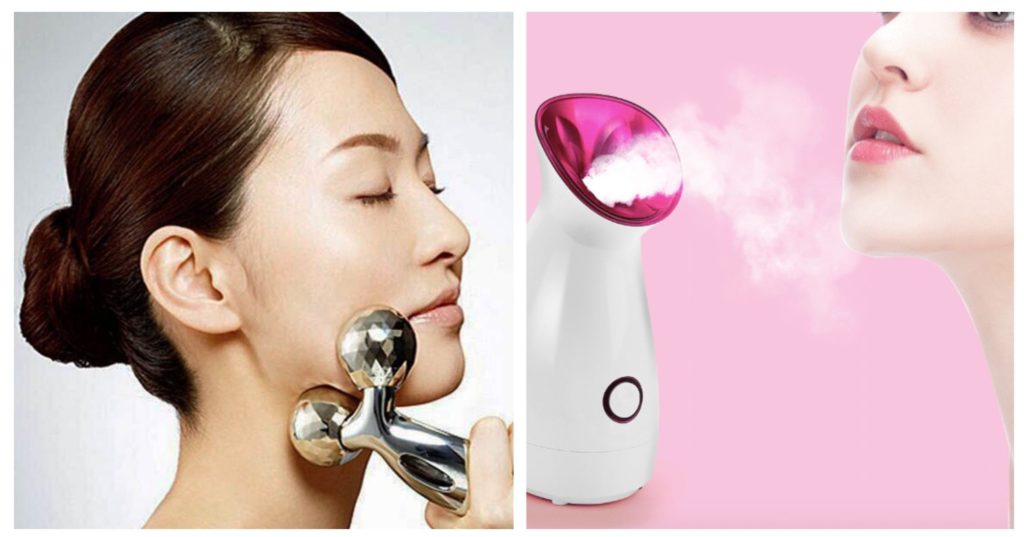
What are the beauty devices’ growth factors?
The key factors driving the market growth of the beauty devices market in China are:
- Rise in the aging population
- Rising disposable incomes and consumerism
- Increasing consciousness toward physical appearance
- Increasing exposure to pollution and UV rays is causing an increasing number of infections and skin and hair problems
- Artificial intelligence (AI) which led to customizable beauty routines at home
- Mobile applications designed to accompany beauty devices
- Magnetic beauty devices
The demand for beauty devices is anticipated to remain the largest in the spas and salons due to the large consumer base opting for personal and beauty care at spas and salons.
However, with technological advancements, development of hand-held devices, and cheaper products, the demand for at-home beauty devices is increased in recent times.
Artificial intelligence (AI) is creating great consumers experiences
Customer experience is enhanced by the digital transformation of the beauty industry in China, such as:
- Automated retail which, after having scanned the machine’s QR code, offers the possibility to access the product page, to be able to follow the online store on Tmall and buy products at little price and in a short time.
- Virtual makeup try-on & removal which offers consumers to try products like lipstick, eye shadow, blush, and eyebrows pencil in less than a second, then, buy these products after digitally trying them on.
- The voice-guided mirror can offer professional skin testing, sunscreen index inquiry, beauty reminders, and beauty knowledge.
- Mobile apps for skin diagnosis like La Roche-Posay spot scan which, based on thousands of photos of the skin and created in collaboration with dermatologists, uses selfies and AI to recommend the right anti-acne routine allowing consumers to obtain a skin diagnostic from a photo of their face taken by a smartphone.
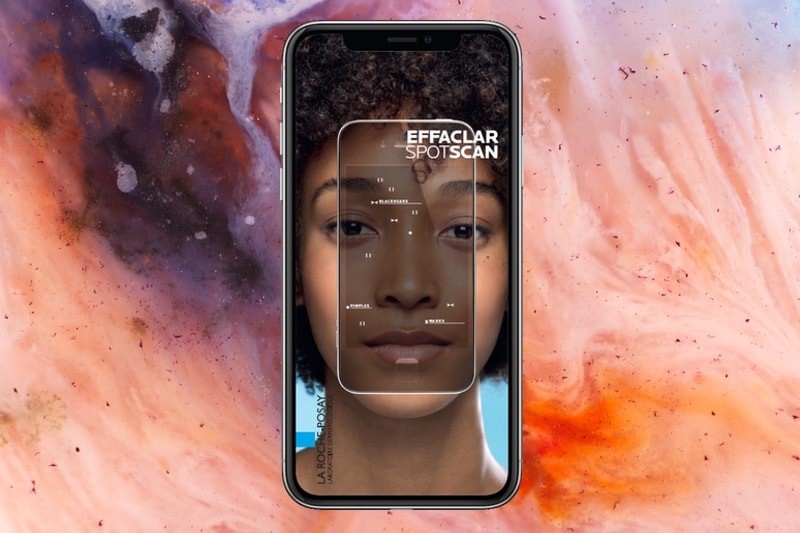
Home-use beauty devices
Thanks to the increase in disposable income, and therefore to the accessibility of beauty devices for home use and for personal care and beauty services, home-use beauty devices is becoming a fast-growing sector in the Chinese beauty market.
More and more people are inclined towards using beauty devices at home rather than visiting a salon or spa for several reasons:
- Easy to use
- Value for money
- Faster results
To reach the demand, for example, Olay launched the Regenerist Cellscience Essence that is teamed with a magnetic applicator, a beauty device powered by micro-current technology and designed to maximize the hero ingredient niacinamide.
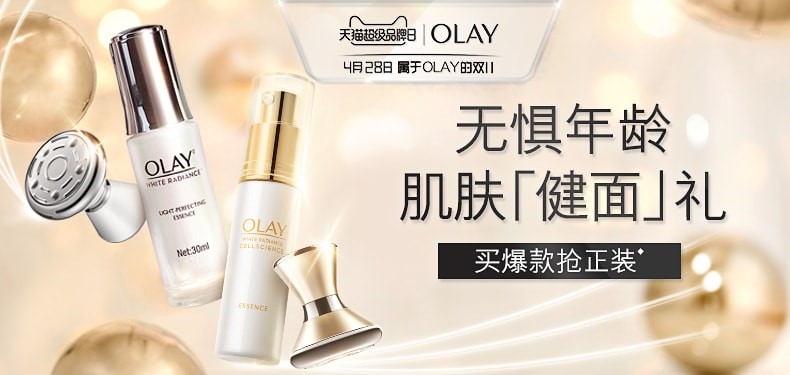
What are the major players?
Some of the players operating in China’s beauty devices industry are:
- Philips – Dutch multinational conglomerate, Philips, is well-known globally for its wide range of electronic products, including beauty devices such as facial cleansing brushes and IPL hair removal devices.
- Panasonic – Japanese manufacturer, Panasonic, offers a variety of beauty devices like facial steamers and eye care equipment that are popular in China.
- Nu Skin Enterprises – This American company sells a variety of beauty and wellness products globally. Its ageLOC skincare devices are popular among Chinese consumers.
- L’Oréal (Clarisonic) – While L’Oréal announced the shutdown of Clarisonic in 2020, their skincare devices had been popular in the Chinese market.
- Foreo – A Swedish beauty tech company, known for its “Luna” line of skin care devices.
- Ya-Man – A Japanese beauty device maker, well known for its facial rollers and cleansing brushes.
- Procter & Gamble (Braun, SK-II) – P&G brands like Braun, known for its hair removal devices, and SK-II, known for its smart beauty devices, have a considerable market in China.
- Amorepacific (IOPE) – IOPE, a subsidiary of South Korean beauty giant Amorepacific, launched a skin beauty gadget called “IOPE Derma Repair Cica Device” in the Chinese market.
- TriPollar – An Israeli company known for its radiofrequency skin tightening devices.
- Home Skinovations (Silk’n) – Silk’n has a range of beauty devices from hair removal to skin tightening that are available in the Chinese market.
- Estée Lauder (La Mer) – Known for their high-end skincare products, they also offer beauty devices.
How to enter the beauty devices market?
Brands that want to enter the Chinese market should understand that Chinese consumers don’t buy products from foreign brands they don’t know. For this reason, brands should focus their marketing strategies on Branding.
Given the widespread use of the internet to look for and buy products in China, how can brands create branding in China’s digital ecosystem?
Be visible on Baidu Chinese search engine:
- Your website should be hosted in China
- You should get an ICP license
- Your website should be in Mandarin
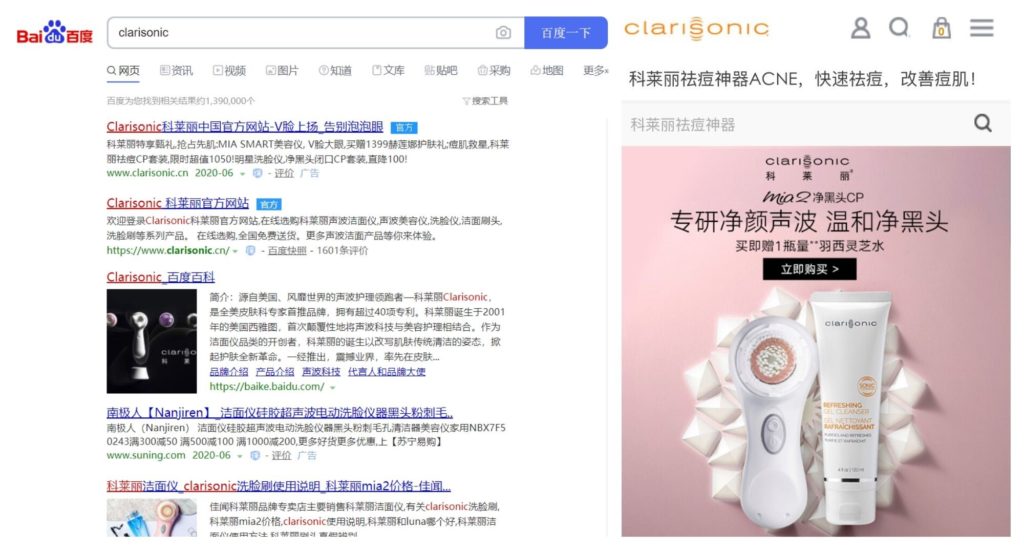
Social Media
China is the largest social media market in the world, with people increasingly addicted to these platforms. However, in China Facebook, Whatsapp, Twitter don’t work, therefore people use Chinese social media.
The major used social media are WeChat (1.165 billion monthly active users), Weibo (520 million monthly active users), Xiaohongshu (85 million monthly active users), and Douyin (475 million monthly active users).
They spend a lot of time on these platforms doing everything like:
- look for places, brands, and people
- share their opinions
- ask for product advice
- connect with others
For this reason, brands should focus on this platform to:
- Reach the majority of Chinese people
- Increase brand awareness
- Create engagement
- Create brand loyalty
- Increase sales
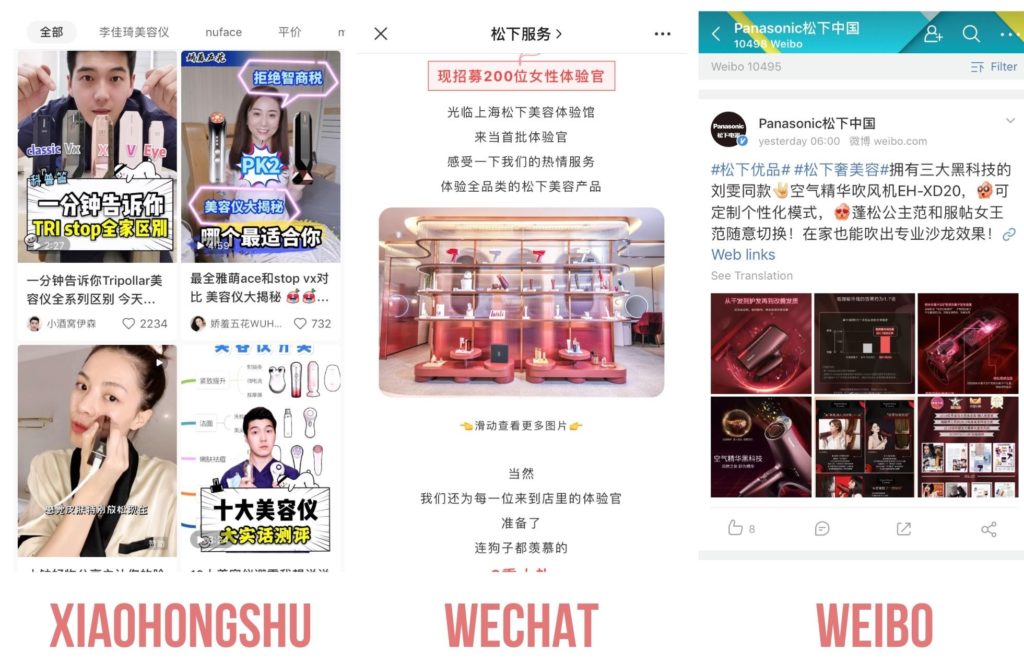
PR : Forums & KOLs
In China, E-reputation is key to success. PR is a good way to build your credibility. Not only you are getting experts talking about you, but it also means backlinks from authority websites.
In addition, brands should complete PR efforts and strengthen their credibility using forums (like Zhihu) and KOLs (Key Opinion Leaders) to talk about you. KOLs are very powerful and widely listen to the Chinese internet. Their opinion matters the most.
GMA can help you create a community around your brand and connect you to the right KOLs.
For example, domestic top beauty device brands like AMIRO, NOWMI, and Jmoon are experiencing rapid growth thanks to their effective use of KOC marketing. These brands have successfully reached a larger audience through the extensive utilization of short videos and live-streaming. The sales volume of beauty devices on Douyin, a live-streaming e-commerce platform, reached 3.3 billion RMB in 2022, with a year-on-year rise of 102.22%.
How to sell your beauty devices in the Chinese market?
In addition to Weibo, WeChat and Douyin which also offer you the possibility to sell your products through in-app links that refer to external e-commerce platforms, brands have 2 choices:
- Sell your products through e-commerce platforms like Tmall, Xiaohongshu, Pinduoduo and JD.com.
- Sell your products through cross-border e-commerce platforms like Kaola, JD worldwide, Tmall global, without having to face the long and complex authorization procedure with local authorities, which is mandatory for export and sale through traditional channels.
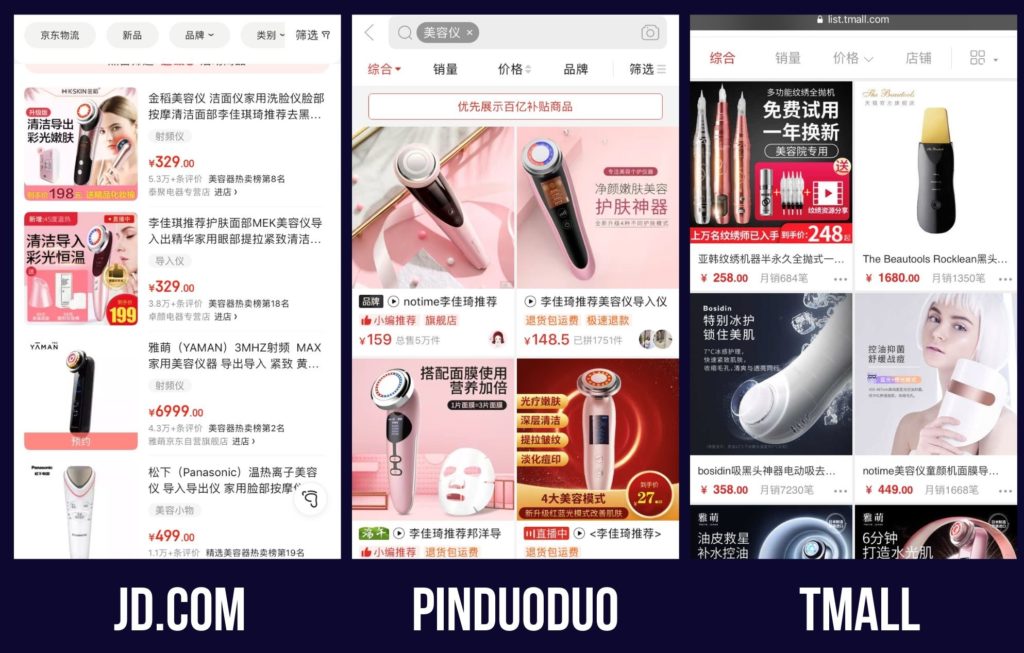
We are your local partner in China! Contact us!
The beauty devices market in China has experienced significant growth of 325% on Tmall. This indicates a rising demand for beauty devices among Chinese consumers.
The market’s rapid expansion suggests that more and more people are embracing the use of these devices to enhance their beauty routines. This trend highlights the potential for further growth and opportunities in the beauty device industry in China.

Collaborating with an agency specialized in the Chinese market is the best way to achieve your goal and increase your Return On Investment. As all companies are different, the marketing and advertising strategy must be tailored according to their needs and within their financial means.
Proud of the success of the companies we have helped over the years, we know exactly what a certain company needs.

Thus, if you have questions about selling, advertising, exporting, etc. your cosmetics in China, contact us directly, and we will reply to you within 24 hours.


2 comments
Jamar Holt
Yes, I love this place
cami
I have read your blog it’s really good